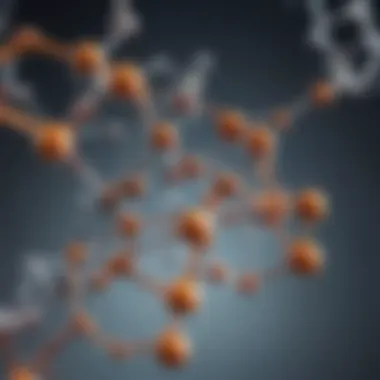Phenyl Grignard: Properties, Synthesis, and Applications


Intro
Phenyl Grignard reagents are crucial tools in organic chemistry. They enable scientists to perform various synthetic tasks with ease and precision. Understanding the properties and applications of these reagents is essential for students, researchers, and professionals in the field. This article aims to provide a comprehensive overview of phenyl Grignard reagents, diving into their synthesis, associated reaction mechanisms, and their significance in both academic and industrial contexts.
Research Overview
Summary of Key Findings
Phenyl Grignard reagents exhibit unique properties that make them favorable for a range of synthetic applications. Key findings include:
- High reactivity with electrophiles
- Ability to introduce the phenyl group into different molecular structures
- Versatility in creating diverse organic compounds
These reagents play a vital role in various synthetic pathways, impacting fields such as pharmaceuticals and agrochemicals. They can be employed in diverse reactions including nucleophilic additions, which are fundamental in building complex molecules.
Importance of the Research
The significance of understanding phenyl Grignard reagents cannot be overstated. They serve as a foundational element in organic synthesis. Their ability to facilitate complex transformations highlights their utility in developing new drugs and materials. Additionally, phenyl Grignard reagents offer insights into reaction mechanisms that are critical for advancing knowledge in organic chemistry. This research also opens avenues for future studies, enabling the exploration of novel applications and the development of more efficient synthetic strategies.
Methodology
Study Design
This article synthesizes existing literature on phenyl Grignard reagents. It presents a structured approach by breaking down various aspects, from synthesis to application, ensuring a clear understanding of their role in contemporary organic synthesis.
Data Collection Techniques
Data for this article was collected through:
- Review of peer-reviewed journal articles
- Analysis of textbooks focusing on organic chemistry
- Examination of online resources and databases
The integration of these sources ensures a thorough and accurate representation of the topic.
"Phenyl Grignard reagents are essential in the toolkit of organic chemists, marrying simplicity in application with profound implications for synthetic chemistry."
Through this exploration, readers will gain a better understanding of the intricacies surrounding phenyl Grignard reagents and their broader implications for the scientific community.
Understanding Grignard Reagents
Understanding Grignard reagents is crucial for anyone studying organic chemistry. These reagents play a pivotal role in diverse chemical reactions, especially in forming carbon-carbon bonds. The significance of Grignard reagents extends well beyond academic study; they have practical applications in pharmaceuticals, agriculture, and various industrial processes. A deep dive into their properties, synthesis, and functioning will uncover how these compounds enable the construction of complex organic molecules.
Definition and Background
Grignard reagents are organomagnesium compounds characterized by the formula RMgX, where R represents an organic group and X is a halogen. Their creation involves the reaction of magnesium with organic halides, leading to a versatile class of reagents that function as powerful nucleophiles. This allows Grignard reagents to readily react with electrophiles to form new carbon-carbon bonds. The understanding of these reagents is fundamental for conducting various reactions in organic synthesis, solidifying their importance in contemporary chemistry.
Chemical Structure
The structure of Grignard reagents is crucial to their reactivity. In the RMgX formula, the carbon atom binds to magnesium through a polar covalent bond. This bond gives rise to a partial positive charge on magnesium and a partial negative charge on the carbon. Such a configuration makes the carbon atom highly nucleophilic, rendering it capable of attacking electrophiles effectively. The chemical behavior of these reagents is influenced significantly by the nature of the R group and the halogen X attached. For example, phenyl Grignard, where R is a phenyl group, shows unique reactivity patterns compared to alkyl Grignard reagents.
Historical Context
The discovery of Grignard reagents dates back to 1900 when Victor Grignard synthesized the first of these compounds. His work was pivotal and earned him the Nobel Prize in Chemistry in 1912. The initial research laid the groundwork for further explorations into the reactivity and applications of Grignard reagents. Over the years, they have been emphasized in literature, expanding their importance within organic synthesis. Historically, insights gained from Grignard's experiments have driven innovation in synthesizing various organic compounds, underscoring the reagent's vital role in advancing organic chemistry as a disclipine.
"The arrival of Grignard reagents marked a significant turning point in chemical synthesis, transforming the landscape of organic chemistry."
In summary, understanding Grignard reagents is indispensable for anyone in the chemistry field. Their unique definition, chemical structure, and rich historical background contribute to their wide array of applications and profound impact on organic synthesis.
Synthesis of Phenyl Grignard Reagents
The synthesis of phenyl Grignard reagents represents a crucial area in organic chemistry. This process allows chemists to create highly reactive compounds, which play a significant role in various synthetic pathways. Understanding the synthesis process provides key insights into their properties and applications. Benefits include their ability to form stable reactants that efficiently participate in nucleophilic addition reactions. However, the syntheis involves careful considerations regarding the choice of starting materials and preparation techniques, ensuring both safety and effectiveness.
Starting Materials
To synthesize phenyl Grignard reagents, the selection of starting materials is pivotal. Generally, an aryl halide is combined with magnesium. The most commonly used aryl halide is bromobenzene. Using bromobenzene allows for efficient formation of phenyl magnesium bromide, thus gaining interest for its suitable reactivity.
Key factors to consider include:
- The reactivity of the halide: Bromides react more readily than chlorides due to weaker C-Br bonds.
- The purity of starting materials: Any contaminants can interfere with the synthesis process and affect yields.


Reagent Preparation Techniques
Several techniques exist for preparing phenyl Grignard reagents, two of which are outlined here: halide reactants and magnesium insertion method.
Halide Reactants
In the halide reactant method, an aryl halide such as bromobenzene is reacted with magnesium in an anhydrous ether solvent. This method is widely recognized due to its simplicity and efficiency. Importantly, the use of ether provides an aprotic environment conducive to the formation and stability of the Grignard reagent.
Key characteristics: The method often yields high purity and concentration of the Grignard reagent. It's a beneficial choice due to its straightforward procedure and general accessibility.
Advantages: Simplified setup and relatively high yields.
Disadvantages: Sensitivity to moisture must be accounted for; any water can deactivate the Grignard reagent.
Magnesium Insertion Method
The magnesium insertion method involves inserting magnesium into an aryl halide solution, which can lead to the rapid formation of Grignard reagents. This method can produce –phenyl Grignard reagents in a highly controlled and selective manner. It stands out acutely when dealing with destructive applications or sensitive compounds.
Key characteristic: This method allows for versatile applications in synthesis, often yielding more stable intermediates than traditional values.
Advantages: Useful for developing complex structures where other methods might falter.
Disadvantages: Requires meticulous control over reaction conditions to avoid side reactions.
Safety and Handling
Safety is paramount when dealing with phenyl Grignard reagents, owing to their highly reactive nature. Precautions should include:
- Always work in a fume hood to avoid inhalation of toxic vapors.
- Use gloves and protective eyewear to minimize direct exposure.
- Ensure that all glassware is dry before use, as moisture can lead to violent reactions.
Careful handling and knowledge about these reagents are essential for ensuring successful synthetic applications while maintaining safety in the laboratory.
Mechanisms of Reaction
Understanding the mechanisms of reaction is critical when working with phenyl Grignard reagents. These mechanisms not only provide insights into how these reagents interact with various substrates, but also inform methods of optimization in synthetic chemistry. By dissecting the mechanisms at play, researchers can tailor reaction conditions to enhance efficiency, yield, and selectivity. This section will explore the three primary types of mechanisms involved with phenyl Grignard: nucleophilic mechanism, electrophilic addition, and the stability of intermediates. Each of these elements offers vital information about the behavior of phenyl Grignard in different contexts.
Nucleophilic Mechanism
The nucleophilic mechanism is fundamental to the function of phenyl Grignard reagents. This mechanism often initiates the reaction process. A phenyl Grignard acts as a strong nucleophile due to the presence of the highly reactive carbon atom attaching the magnesium halide bond. In essence, when phenyl magnesium bromide reacts with electrophiles, the nucleophilic attack occurs first.
The phenomenon can be described as follows:
- The carbon atom bonded to magnesium in phenyl Grignard donors its electron to the electrophile.
- This results in the formation of a new bond.
- Subsequently, the magnesium halide bond is broken, releasing the halide ion.
This ability to act as a nucleophile is crucial in the synthesis of various organic compounds, including alcohols and other substrates. It defines the functional potential of phenyl Grignard reagents, making them indispensable in organic chemistry.
Electrophilic Addition
Electrophilic addition is a key component in the reaction mechanisms involving phenyl Grignard reagents. After the nucleophilic attack, an electrophilic species commonly acts by welcoming the highly electronegative carbon atom from the Grignard reagent. In this stage, the two components engage through a series of electron-pair shifts that stabilize the resulting structure.
Electrophilic addition can be outlined in the following phases:
- The nucleophile from the phenyl Grignard temporarily binds to the electrophile.
- The creation of a bond between these species leads to a transition state.
- Finally, the product forms as the reaction stabilizes, typically resulting in a new organic compound.
Typically, this mechanism is vital when synthesizing compounds like aldehydes or ketones, allowing for complex organic transformations.
Stability of Intermediates
The stability of intermediates plays a significant role in determining the overall efficiency of reactions involving phenyl Grignard reagents. The intermediates formed during the nucleophilic and electrophilic stages can have various degrees of stability, which influences the yield and rate of reactions.
Key factors affecting the stability include:
- Sterics: Bulky groups near the reacting center can hinder the formation of stable intermediates, thus slowing down the reaction.
- Electronics: The electron density around the intermediates can influence their reactivity. Systems with high electron density may experience instability due to increased repulsion.
- Solvent Effects: The choice of solvent can also stabilize or destabilize intermediates, impacting reaction outcomes.
Understanding the stability of intermediates helps chemists to predict reaction pathways and optimize conditions for desired results.
In summary, the mechanisms of reaction involving phenyl Grignard reagents are essential for mastering organic synthesis. These mechanisms not only guide the reaction process but also allow for precision in techniques, which ultimately enhances the field of organic chemistry.
Applications in Organic Synthesis


The role of phenyl Grignard reagents in organic synthesis cannot be overstated. They serve as powerful nucleophiles in various chemical transformations, allowing for the formation of complex organic molecules. These reagents contribute significantly to the field by facilitating reactions that lead to the construction of various functional groups, such as alcohols, aldehydes, and ketones. Understanding their applications is crucial for chemists engaging in synthesis, as they often seek efficient pathways to create desired compounds.
Formation of Alcohols
One of the primary applications of phenyl Grignard reagents is in the formation of alcohols. In this reaction, the phenyl Grignard acts as a nucleophile, attacking a carbonyl carbon of an aldehyde or ketone. This results in the formation of an alkoxide intermediate, which can be subsequently protonated to yield the corresponding alcohol. The versatility of phenyl Grignard reagents allows for the synthesis of both primary and secondary alcohols, depending on the carbonyl compound utilized.
In organic synthesis, alcohols are key intermediates and final products, playing essential roles in pharmaceuticals, agrochemicals, and fine chemicals. They can undergo further transformations, making them critical building blocks in elaborate synthetic schemes. This ability to derive alcohols from phenyl Grignard reagents highlights their importance in practical applications.
Synthesis of Other Organic Compounds
Aldehydes
Phenyl Grignard reagents can also be utilized in the synthesis of aldehydes. When reacting with certain electrophiles, such as acyl chlorides, they can effectively introduce a phenyl group to the carbon framework, leading to the formation of aldehydes. The key characteristic of aldehydes produced through this method is their high reactivity, especially in further transformations. This reactivity makes aldehydes a beneficial choice in organic synthesis, as they can easily participate in condensation reactions, for example.
Aldehydes possess a distinctive functional group, the carbonyl group, located at the terminal end of the molecule. This positioning makes them excellent substrates for a variety of reactions, offering chemists multiple pathways for functionalization and derivatization. However, they can also be prone to over-oxidation, a limitation to consider in synthetic applications.
Ketones
In addition to aldehydes, phenyl Grignard reagents are instrumental in the synthesis of ketones. Ketones typically arise when phenyl Grignard reagents react with acyl chlorides, similar to aldehyde synthesis. The key characteristic of ketones is their stability when compared to aldehydes, making them valuable intermediates in synthetic pathways. This stability allows chemists to work with them under a wider range of conditions without fear of undesirable side reactions.
Ketones are also popular due to their utility in synthesizing a variety of functional materials. They can undergo nucleophilic addition reactions, oxidation, and many other transformations, contributing significantly to the overall flexibility of synthetic methodologies. While they provide numerous synthesis options, ketones can also present challenges in terms of selectivity, particularly in reactions involving multiple functional groups.
Use in Polymerization Processes
Finally, phenyl Grignard reagents have applications in polymerization processes. Their unique ability to act as both nucleophiles and initiators in certain polymerization reactions allows for the development of new polymer materials with tailored properties. This is particularly relevant in the field of materials science, where customized polymers can significantly impact industries ranging from textiles to electronics.
Phenyl Grignard reagents enhance synthetic pathways, leading to diverse applications in organic synthesis, from small organic molecules to larger polymer constructs.
The versatility in their applications further reinforces the significance of phenyl Grignard reagents within the organic synthesis landscape, making them essential tools for chemists aiming to innovate and expand the boundaries of chemical manufacturing.
Advantages and Limitations
Understanding the advantages and limitations of phenyl Grignard reagents is crucial for researchers and practitioners in organic chemistry. These factors significantly impact how chemists utilize these reagents in various synthetic pathways. Through this exploration, we gain insights into not only their effectiveness but also the challenges they present. This understanding informs decisions about their use in industrial applications, pharmaceutical synthesis, and research initiatives.
Solubility and Reactivity
Phenyl Grignard reagents possess notable solubility in organic solvents such as diethyl ether and tetrahydrofuran. This solubility enhances their reactivity when involved in chemical reactions. Their capability to act as nucleophiles allows for rapid interaction with electrophiles, facilitating the synthesis of desired products. However, the solubility does present challenges; for instance, solvents that can dissolve these reagents might also participate in side reactions, thereby affecting yield and purity.
Therefore, while high reactivity enhances their utility, careful selection of solvents is paramount to ensure optimal performance in synthetic processes.
Challenges in Handling
Handling phenyl Grignard reagents requires significant caution. They react violently with water and undergo hydrolysis, which leads to the formation of by-products that may compromise targeted syntheses. Therefore, all glassware and instruments must be dry to avoid moisture contamination.
Moreover, they are highly sensitive to air, especially in the presence of moisture. This necessitates the use of inert atmospheres, like nitrogen or argon, during reactions and storage. Such requirements can be a barrier, particularly in less controlled laboratory environments. Understanding these handling challenges can aid in developing protocols that maximize safety and reaction efficiency.
Selectivity in Reactions
The selectivity of phenyl Grignard reagents in reactions can be both an advantage and a limitation. They typically exhibit a high degree of selectivity when reacting with electrophiles, which enhances the formation of specific products. This selectivity is crucial for synthesizing complex organic molecules, especially in pharmaceutical applications where specific pathways must be followed.
However, this selectivity does not always guarantee the desired outcome. Some reactions may lead to unexpected by-products due to competing mechanisms. Additionally, phenyl Grignard may not always react in a predictable manner with certain functional groups, limiting their use in more complex symthesis. Chemists must navigate these selectivity issues effectively by optimizing reaction conditions and choosing appropriate substrates.
Understanding the advantages and limitations of phenyl Grignard reagents is essential for effectively leveraging their power in organic synthesis.
This section thus provides a nuanced view of the practical aspects that researchers must consider when employing phenyl Grignard as a tool in synthetic chemistry.
Comparison with Other Organometallics
Comparing phenyl Grignard reagents with other organometallic compounds is fundamental for understanding their unique role in organic chemistry. This comparison provides insights into their reactivity, selectivity, and the specific applications where phenyl Grignard excels. Organometallics are vital in numerous chemical reactions, but each type presents distinct characteristics that affect performance. Grignard reagents, especially aryl variants like phenyl Grignard, exhibit exceptional nucleophilicity, making them critical for several synthetic pathways.
Alkyl vs. Aryl Grignard Reagents
Alkyl Grignard reagents are formed by combining alkyl halides with magnesium, producing organomagnesium halides. They are commonly employed in nucleophilic addition reactions. In contrast, aryl Grignard reagents, such as phenyl Grignard, use aryl halides. A key difference is their reactivity: alkyl Grignard reagents are generally more reactive due to the presence of sp3 hybridized carbon, while aryl Grignard can engage in distinct reactions due to their aromatic nature. This affects their utility in synthesizing complex molecules.
For instance, phenyl Grignard reagents can react with carbonyls, forming alcohols, but they must be handled with caution since they can also lead to side reactions. They are less reactive than their alkyl counterparts but offer selectivity that can be advantageous when aiming for specific products.
Metallic Variants
Metallic variants of Grignard reagents include those that utilize different metals, such as lithium or zinc, instead of magnesium. These substitutions can alter the chemical properties and reactivity of the resulting organometallic compound. Lithium organometallics, for example, may exhibit greater stability and solubility in certain solvents compared to magnesium counterparts. This is important for reaction conditions as it can influence the choice of reagents and solvents in synthetic protocols.


Comparing these variants can lead to enhanced understanding in different settings, particularly in large-scale syntheses.
"The choice of which organometallic to use can greatly influence both the efficiency and selectivity of the reaction."
Alkyl and aryl reagents serve specific roles, but there is no one-size-fits-all answer. Each class, including metallic variants, offers unique benefits that depend on the desired reaction and the specific chemical transformations being pursued. Thus, steering choices towards the appropriate Grignard or metallic alternative can yield better results in industrial applications.
Case Studies in Industrial Applications
The examination of case studies in industrial applications of phenyl Grignard reagents provides valuable insight into their practical utility. This section emphasizes not only the significance of these reagents in real-world chemistry but also their economic and efficiency advantages in complex synthesis scenarios.
Pharmaceutical Synthesis
Phenyl Grignard reagents play a critical role in the pharmaceutical industry. Their reactivity allows for the formation of vital intermediates used in the production of numerous therapeutic compounds. For example, they assist in the synthesis of analgesics and anti-inflammatory drugs. The nucleophilic nature of phenyl Grignard facilitates the addition to electrophilic centers like carbonyls, leading to alcohols that are essential precursors in drug development.
A notable case is the development of the pain relief drug Ibuprofen. The complex synthetic pathway utilizes phenyl Grignard for forming key intermediate structures that enable the final product's creation. The ability to introduce the phenyl group through Grignard chemistry allows for greater specificity and complexity in the synthesis process. This specificity also aids in producing compounds that require stringent purity standards, which is crucial in pharmaceuticals.
The advantages in using phenyl Grignard reagents include:
- High yield of desired products.
- Versatility in synthesizing various classes of pharmaceuticals.
- Cost-effectiveness due to fewer steps in synthetic pathways.
However, they also come with some challenges, such as handling moisture sensitivity and the need for dry solvents. Manufacturers often implement strict protocols to mitigate these risks.
Agricultural Chemicals
In the realm of agricultural chemicals, phenyl Grignard reagents serve a critical purpose. They are employed in the synthesis of herbicides, pesticides, and fungicides. The ability to modify the phenyl group opens pathways to create new agricultural products that are more effective against a range of pests and diseases.
One pertinent example is the synthesis of the herbicide Glyphosate. Through various reactions involving phenyl Grignard, manufacturers can introduce essential functional groups that enhance the herbicide's efficacy. The use of phenyl Grignard in forming intermediates also allows for smoother and more efficient pathways to achieve the final product.
The use of phenyl Grignard reagents in agricultural chemistry presents several key benefits:
- Enhanced efficacy of compounds through structural modifications.
- Lower environmental impact by creating more targeted applications.
- Improved production methods leading to higher overall yield in less time.
However, as in pharmaceuticals, handling and application of these reagents in agriculture must follow stringent guidelines, particularly regarding environmental and health safety.
"Phenyl Grignard reagents not only exhibit remarkable versatility in synthesis but significantly drive forward the capabilities in both pharmaceutical and agricultural domains, integrating efficiency and innovation into industrial applications."
Through these case studies, it is evident that phenyl Grignard reagents are integral to the synthesis of critical compounds across various industries. Their impact on improving yield, economizing production, and facilitating complex reactions highlights their value in current industrial chemistries.
Future Directions in Research
Exploring the future directions in research for phenyl Grignard reagents is essential for advancing their applications in organic synthesis. The ongoing development of new methodologies and optimization of existing processes can lead to greater efficiency and sustainability in chemical reactions. This exploration can be delineated into two focal points: the development of new reactions and the adoption of green chemistry approaches.
Developing New Reactions
Innovative reaction pathways can unlock the full potential of phenyl Grignard reagents. Researchers aim to expand their utility beyond traditional applications. Some areas for exploration include:
- Diversifying Reaction Types: New synthetic routes can incorporate phenyl Grignard reagents into different reaction mechanisms, such as cross-coupling reactions. Methods like the Suzuki or Negishi reactions could benefit from enhanced selectivity or new coupling partners.
- Improving Reaction Conditions: Adjusting the temperature, solvents, or reaction times can lead to enhanced yields and lower by-product formation. Research may focus on solvents that could be recycled or used more efficiently.
- Functional Diversity: Future studies may investigate the reactivity of various substituents on phenyl rings. These improvements might allow for more complex structures with functional groups vital for drug development and polymer science.
Each of these avenues requires detailed understanding of reaction mechanisms and the conditions under which phenyl Grignard reagents operate. The potential advancement in our understanding can significantly shape the future of synthetic chemistry.
Green Chemistry Approaches
The growth of green chemistry ideals is central to contemporary research. As chemists strive to minimize the environmental impact of their work, phenyl Grignard reagents are no exception. Here are some considerations in this domain:
- Reducing Waste: Efforts can focus on streamlining procedures to minimize by-products. This approach may involve evaluating the stoichiometry or using less hazardous materials in reactions.
- Renewable Resources: Investigating bio-based starting materials offers a sustainable alternative to conventional ones. Those resources can lead to more environmentally friendly synthesis chains.
- Energy Efficiency: Researchers are also considering energy-efficient processes, potentially developing reactions that proceed at room temperature or utilizing light as a catalyst.
- Catalyst Usage: Instead of using stoichiometric quantities of reagents like magnesium, employing catalytic conditions can also be an area of exploration.
"The field of organic synthesis is always evolving, and advancements in phenyl Grignard research could have profound impacts across various industries, particularly in pharmaceuticals and materials science."
Continued exploration in these areas will be crucial for researchers aiming to push the boundaries of what is possible in organic reaction design.
Finale
The conclusion serves as a crucial synthesis of the insights discussed throughout this article on phenyl Grignard reagents. This final section highlights the overarching importance of these compounds in organic chemistry, emphasizing their unique role in enabling advanced synthetic strategies. Phenyl Grignard reagents not only act as versatile nucleophiles but also contribute significantly to the formation of various organic compounds, making them indispensable tools for chemists.
Summary of Findings
In summary, several key points emerge regarding phenyl Grignard reagents:
- Versatility in Synthesis: Phenyl Grignard reagents are effective in forming alcohols and other crucial organic compounds like aldehydes and ketones. Their application in diverse reactions showcases their functional utility.
- Mechanistic Insight: The detailed mechanisms, including nucleophilic attacks and electrophilic additions, underline the subtleties involved in reactions with phenyl Grignard. Understanding these reactions can aid in improving selectivity and yield in various synthetic pathways.
- Industrial Relevance: Their significance in pharmaceutical synthesis and the production of agricultural chemicals marks them as vital reagents in the chemical industry. These applications highlight the practical value of phenyl Grignard reagents beyond academic settings.
- Challenges and Limitations: While phenyl Grignard reagents have numerous advantages, there are also challenges such as instability in air and moisture, which must be carefully managed.
Implications for Future Research
Examining phenyl Grignard reagents opens several avenues for future research, which may include:
- Development of New Reactions: Ongoing exploration into the reactivity profiles of phenyl Grignard can lead to innovative reaction conditions or new applications, improving efficiency in organic synthesis.
- Green Chemistry Approaches: As there is a growing emphasis on sustainable chemistry, researching eco-friendly methods for working with Grignard reagents could align synthetic processes with environmental considerations.
- Improved Handling Techniques: Developing enhanced protocols for the safe stabilization and handling of Grignard reagents will be vital for industry and academia alike.



